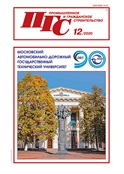BACK
- BUILDING STRUCTURES, BUILDINGS AND FACILITIES
- About the New Version Of SP 15.13330.2020 "Stone And Reinforced Stone Structures"
- UDC 624.012.2/.25(083.75) DOI: 10.33622/0869-7019.2020.12.68-75
Arkady V. GRANOVSKIY, e-mail: GranovskiyAV@mgsu.ru
Moscow State University of Civil Engineering (National Research University), Yaroslavskoe shosse, 26, Moscow 129337, Russian Federation
Abstract. Two editions of SP 15.13330 were analyzed, taking into account the state of scientific research in the field of stone structures. The values of stone masonry safety coefficients proposed in the Set of rules for various types of its stress state, used both in the design of new structures and in conducting experimental studies, taking into account the transition from temporary masonry resistances to its design characteristics, are considered. There is an incorrect solution to this issue from the point of view of the reliability of the proposed coefficients obtained not from experimental studies, but based on the own experience of the developers of the regulatory document. The results of experimental studies of the tensile strength of masonry walls during bending are presented. On the basis of statistical processing of test results the data on the coefficients of the transition (variability) of masonry walls under tension with bending is obtained. The inaccuracy of the description of the calculated characteristics of masonry walls with the simultaneous use of the terms "brand strength" and "compressive strength class" is indicated. The coefficients of variation proposed in the document for cellular concrete blocks used for the transition from branded strength to classes do not correspond to the actual state of affairs in the construction industry and do not contribute to the improvement of block manufacturing technology. Structural solutions of walls made of large-format multi-cavity ceramics are considered. Attention is focused on the need to use composite meshes for masonry walls in order to avoid accumulation of mortar in the cavities of stones, which leads to overspending of the binder and to violation of the thermal characteristics of masonry.
Key words: stone structures, estimated and temporary masonry resistances, safety coefficient, large-format ceramic stone, composite mesh. - REFERENCES
1. Polyakov S. V., Falevich B. N. Proektirovanie kamennykh i krupnopanel'nykh konstruktsiy [Design of stone and large-panel structures]. Moscow, Vysshaya shkola Publ., 1966. 239 p. (In Russian).
2. Dmitriev A. S., Sementsov S. A. Kamennye i armokamennye konstruktsii [Stone and reinforced stone structures]. Moscow, Stroyizdat Publ., 1965. 187 p. (In Russian).
3. Rekomendatsii po primeneniyu stenovykh melkikh blokov iz yacheistykh betonov [Recommendations for the use of small wall blocks made of cellular concrete]. Moscow, TSNIISK im. V. A. Kucherenko Publ., 1992. 127 p. (In Russian).
4. Matveev A. D. Determination of structural safety factors taking into account stress distribution. Vestnik KRASGAU, 2007, no. 3, pp. 159-168. (In Russian).
5. Gorshkov A. S., Vatin N. I. Properties of wall structures made of cellular concrete products of autoclave hardening on polyurethane glue. Inzhenerno-stroitel'nyy zhurnal, 2013, no. 5, pp. 5-19. (In Russian).
6. Grinfel'd G. I, Kharchenko A. P. Comparative tests of fragments of masonry from autoclaved aerated concrete with different types of masonry joints. Zhilishchnoe stroitel'stvo, 2013, no. 11, pp. 30-34. (In Russian).
7. Sokolov B. S., Antakov A. B. Prochnost', zhestkost' i treshchinostoykost' szhatykh kamennykh i armokamennykh kladok [Strength, rigidity and crack resistance of compressed stone and reinforced stone masonry]. Kazan, Tsentr innovatsionnykh tekhnologiy Publ., 2018. 169 p. (In Russian).
8. Sokolov B. S., Antakov A. B., Fabrichnaya K. A. Study of hollow brick masonry 1,4 NF. Izvestiya KGASU, 2009, no. 2(12), pp. 134-139. (In Russian).
9. Sokolov B. S., Antakov A. B., Fabrichnaya K. A. A comprehensive study of the strength of the hollow porous ceramic stones and masonry in compression. Vestnik grazhdanskikh inzhenerov, 2012, no. 5(34), pp. 65-71. (In Russian).
10. Granovskiy A. V. Why standards for masonry structures do not contribute to development of the industry. Promyshlennoe i grazhdanskoe stroitel'stvo, 2015, no. 12, pp. 23-27. (In Russian).
11. Ishchuk M. K. Problems of standards for the design of stone structures. Stroitel'nye materialy, 2010, no. 4, pp. 15-17. (In Russian).
12. Granovskiy A. V. The principle of "let's break in first, and then we'll figure it out" is unacceptable in science. Seysmostoykoe stroitel'stvo. Bezopasnost' sooruzheniy, 2013, no. 1, pp. 48-50. (In Russian).
13. Kurbatskiy E. N., Mazur G. E., Mondrus V. L. Critical analysis of the state of regulatory documentation for the calculation of structures for earthquakes. Academia. Arkhitektura i stroitel'stvo, 2017, no. 2, pp. 95-102. (In Russian). - For citation: Granovskiy A. V. About the New Version of SP 15.13330.2020 "Stone and Reinforced Stone Structures". Promyshlennoe i grazhdanskoe stroitel'stvo [Industrial and Civil Engineering], 2020, no. 12, pp. 68-75. (In Russian). DOI: 10.33622/0869-7019.2020.12.68-75.
BACK


